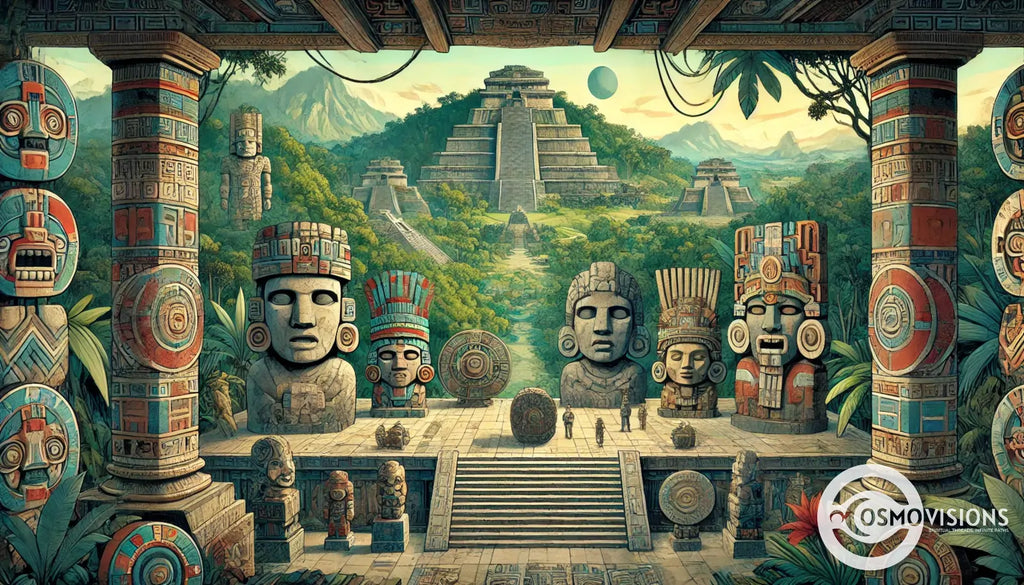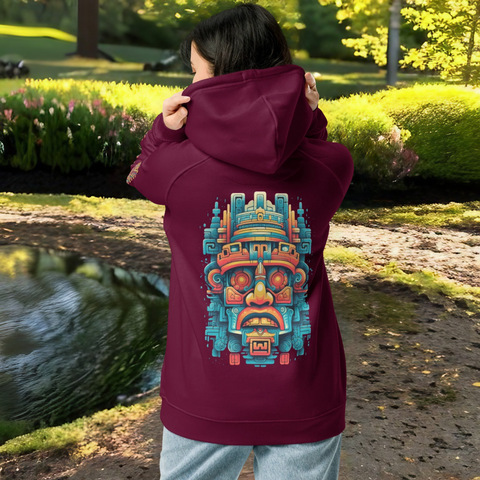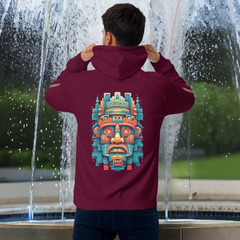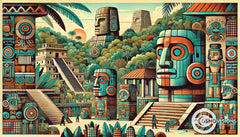The Fascinating World of Olmec Art: Unveiling the Mystery of Olmec Sculpture
Posted by Massimiliano Geraci

Olmec art holds a captivating mystery. Sculptures carved centuries ago offer glimpses into a sophisticated culture’s beliefs and values. Did you know the Olmec people created colossal stone heads over 3 meters tall? Exploring Olmec sculpture introduces artistic techniques mastered before the rise of later Mesoamerican civilizations.
This blog post unravels the fascinating world of Olmec art. We’ll examine iconic works like the giant heads of San Lorenzo and intricate jade carvings. You’ll gain insights into Olmec sculptural methods, materials, and profound symbolism.
You’ll appreciate how Olmec art shaped the region’s artistic trajectory by the end. Are you ready to decode these ancient carvings?
Key Takeaways
1. The Olmec civilization flourished in ancient Mesoamerica between 1500 and 400 BC and produced remarkable sculptural works, including colossal basalt heads weighing up to 50 metric tons and carved from single stone blocks.
2. Iconic Olmec sculptures like the 17 colossal heads found across sites like San Lorenzo depict individualized portraits of rulers, reflecting a cult of rulership and the civilization's organizational capabilities.
3. Olmec artists mastered complex lapidary techniques, carving intricate designs on jade and other precious stones. These designs symbolized concepts central to their cosmology, such as fertility, water, and maize.
4. Olmec sculptures conveyed profound religious symbolism, depicting deities, mythical figures, and iconography like jaguars and serpents. These symbols reflected their spiritual beliefs intertwined with sociopolitical power structures.
5. The artistry and symbolism of Olmec sculptures, including colossal heads, altars, and thrones, profoundly influenced the artistic trajectory of subsequent Mesoamerican civilizations, leaving an enduring legacy.
Iconic Works of Olmec Sculpture
[Iconic Works of Olmec Sculpture]:
Colossal heads stun viewers with astonishing detail and mystery. These gigantic basalt carvings exemplify Olmec's artistic mastery. Olmec artistic styles were influential and adopted by later cultures. Altars and thrones carved from single stone blocks awe the senses.
Their intricate designs reveal complex Olmec beliefs and power structures.
Colossal Heads
The following are two concise and informative paragraphs about “Colossal Heads” as per the given blog outlines, written in clear and simple terms for anthropology, spirituality, and Indios art lovers, following the specified writing styles and instructions.
The Olmec civilization sculpted colossal heads from enormous basalt blocks — monumental stone carvings depicting rulers. These massive sculptures weighed up to fifty metric tons. The giant heads portray mature men with individualized headgear, suggesting a cult of rulership.
Seventeen colossal heads have emerged across four archaeological sites, including San Lorenzo. The sheer size and realism of the Olmec colossal heads is breathtaking. - Michael D. Coe, Archaeologist

Altars and Thrones
Olmec artists crafted awe-inspiring altars and thrones, which are significant Olmec monuments. Carved from massive stone blocks, these monumental works reveal the sophistication of Olmec sculptors. La Venta’s renowned “Mosaic Altar“ exemplifies their mastery.
It represents a sacred cosmic portal, comprising thousands of serpentine and jade pieces. Thrones like San Lorenzo’s intricate carvings display deities and symbolic iconography. Glyphs and motifs conveyed spiritual concepts, rituals, and elite power.
Exploring these artifacts offers insights into Olmec religious beliefs and sociopolitical structures.
Sculptures from Tres Zapotes and El Manatí demonstrate the Olmec artistic canon extended beyond the Gulf heartland. Exquisite works reflect a shared artistic language across Mesoamerica.
Techniques and Materials in Olmec Sculpture
Olmec sculptors exploited basalt and jade’s natural properties. During the Formative Period, which dates from as early as 1200 BCE to about 400 BCE, the Olmecs developed their sculptural techniques, significantly influencing subsequent civilizations. They mastered carving techniques, creating intricate lapidary works.
Use of Basalt and Jade
Olmec sculptors carved stone with expert precision. They favored basalt—a dense, dark volcanic rock. This allowed them to create colossal heads and imposing monuments. They also prized jade’s translucent green hues for smaller carvings. Their jade artistry reached extraordinary heights with symbolic pieces depicting divinities. Jadeite, the finest jade variety, came from remote Guatemalan sources. Yet Olmec lapidary skills metamorphosed this tough stone into breathtaking works. Jade objects communicated concepts of fertility, water, and maize—central to Olmec cosmology.
During the Olmec period, extensive trade networks facilitated the exchange of materials like basalt and jade, significantly impacting the variety and sources of traded items.
Carving and Lapidary Methods
Olmec artisans were masters of stone carving and lapidary arts. They harnessed basalt, jade, and other stones through laborious processes. Basalt's hardness made carving formidable—sculptors employed stone tools and abrasive sands.
Olmec jade workers exhibited remarkable skill in fashioning intricate objects. Grinding, drilling, and polishing transformed rough jade into exquisite adornments. The Olmec lapidary techniques showcased immense artistry and patience.
Olmec sculptors left an indelible mark through monumental carved basalt. Colossal heads and thrones illustrate the sophistication of their stone-carving methods. Smaller jade figurines and ceremonial objects reveal astonishing lapidary craftsmanship.
Symbolism and Interpretation of Olmec Sculptures
Olmec sculptures conveyed profound meanings and insights into their spiritual beliefs. The colossal heads and intricate carvings embodied complex religious symbolism. They depicted divine rulers and mythical figures revered in Olmec cosmology. The significant role of Olmec deities in their religion and mythology, with their distinct features and association with rulership, is also evident in these artworks.
Iconography experts study the iconography of Olmec artworks. Archaeologists excavate artifacts, such as carved monuments, at sites. Art historians analyze stylistic elements and aesthetic principles.
Together they unravel the symbolic significance Olmec artists inscribed in stone sculptures.
Religious and Sociopolitical Roles
Olmec sculptures reveal profound religious symbolism. Colossal heads likely represented elite rulers—deified individuals revered as living gods. Sculptural motifs like jaguars, serpents, and infants suggest complex myths involving human-animal transformations and ritualistic sacrifices. The Olmec Dragon, one of the eight deities, is depicted with flame eyebrows, a bulbous nose, and a bifurcated tongue, indicating its role in religious activities involving elite rulers, shamans, and priests.
These intertwined spiritual and political realms manifested an Olmec theocratic authority.
Monumental altars and thrones embodied sociopolitical power structures. San Lorenzo’s elaborate offerings signify rulers’ control over sacred rites and agricultural fertility rituals.
The Influence of Olmec Religion on Sculpture
Sculptures crafted by the Olmec artists reveal profound religious symbolism and iconography. The colossal heads, carved from immense basalt boulders, depict Olmec rulers adorned with intricate headgear and facial features. The Olmec culture also had a rich array of distinct supernatural beings and religious beliefs.
These monuments signify the divine status of rulers, blending human and supernatural elements. Altar carvings portray the Olmec Maize God, a pivotal deity linked to agriculture’s sacred role.
Jade figurines exhibit powerful feline imagery, representing the revered jaguar spirit guides. The Olmec integrated their spiritual beliefs into every aspect of sculptural art, immortalizing their reverence for nature’s forces and the cosmic order.
Olmec artisans employed intricate lapidary techniques to shape hard, precious stones like jade into exquisite ritual objects. Carvings unearthed at sites like San Lorenzo and La Venta showcase the mastery of these sculptors.

Conclusion
Olmec sculpture is a testament to the ingenuity and artistry of ancient Mesoamerican civilizations. These intricate carvings, hewn from basalt and jade, transcend mere physical forms.
They embody sacred symbols, stories entwined with mythology. Monumental heads gaze upon us, frozen emissaries from a bygone era, beckoning us to unravel their enigmatic narratives.
While mysteries linger, Olmec art illuminates the profound human capacity for creative expression, an enduring legacy etched into the annals of history.
Explore our detailed guide on Olmec religion and its influence on sculpture to discover more about the profound impact of spirituality on ancient art.
FAQs
1. What is the Olmec culture, and where did it originate?
The Olmec were an ancient civilization—the first major Mesoamerican culture—thriving along the Gulf Coast of Mexico, in the region known as the Olmec heartland. Their art style and iconography influenced later cultures across Mexico and Central America.
2. What are some of the most significant Olmec artifacts and sites?
Major Olmec artifacts include colossal stone heads, intricate jade carvings, and unique figurines depicting human-jaguar hybrids. Key Olmec sites like San Lorenzo, La Venta, and Laguna de los Cerros, which are among the major Olmec centers, have yielded monumental sculptures and evidence of ceremonial centers.
3. How did the Olmec influence later Mesoamerican civilizations?
The Olmec are considered the “mother culture” – their advanced artistic traditions, iconography, and even a rudimentary writing system set the foundation for many later cultures in Mesoamerica. Olmec motifs and stylistic elements can be seen in the art of the Maya, Aztecs, and others. The social and political organization of Olmec society, characterized by considerable centralization and hierarchical structures, also influenced these later cultures.
4. What materials and techniques did the Olmec use in their art?
Olmec artists worked with various materials, including jade, serpentine, basalt, and ceramic. Their stone carvings demonstrate incredible skill -- from the colossal heads to intricate figurines and celts. The Olmec also created impressive earthworks and rock art.
5. What mysteries still surround the Olmec civilization?
Despite extensive archaeological research, the origins of the Olmec remain unclear. Their language, ethnic roots, and the extent of their influence are still debated. The purpose of the iconic colossal heads and the meaning behind much of their iconography also continue to elude scholars.
6. How has Olmec art impacted our understanding of ancient Mesoamerica?
The discovery of Olmec artifacts and sites in the 1930s revolutionized our knowledge of the ancient Americas. Their sophisticated art and cultural achievements revealed an advanced civilization predating many later Mesoamerican societies -- reshaping our view of the region's history.






















